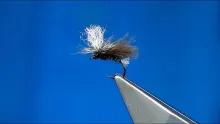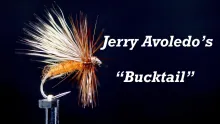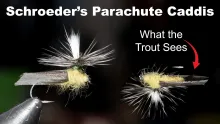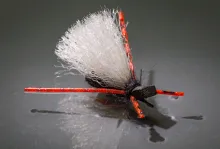Materials Used;
Hook, Size 18
Thread, Sheer 14/0 Black
Body, Peacock Herl
Hackle, Natural Red or Ginger Cock
Wing, Mallard Body/Flank
WILLIAM Arthur Storey, who has died at the age of 93, was a third generation North Yorkshire riverkeeper of national reputation.
He spent his working life tending the River Rye for the historic Ryedale Angling Club, which still flourishes today. Visitors to his little cottage in Helmsley, on the banks of the Rye, could hardly miss it owing to the brass grayling adorning the front door, which Arthurhad made himself during the Second World War from a shell casing.
Arthur Storey’s name and love of fly fishing will be forever associated with the John Storey fly, named after his grandfather, who devised the original pattern.
With its peacock-over-wool body, grey mallard breast feather wing and reddish-brown hackle, the John Storey began life as a wet fly in the early 19th century. By around 1914 it had evolved into a highly effective general purpose dry pattern.
Arthur’s father, Walter, dispensed with the wool underbody (originally included to waterlog and help sink the fly), tied its wing upright, and added a Rhode Island Red cock hackle.
Arthur Storey’s own contribution came in 1935, when he changed the angle of the wing so it sloped forward of the hook eye. This, he freely admitted, was by default, as he struggled to form the original upright wing. The John Storey has been thus tied ever since; however Arthur occasionally substituted the Rhode Island Red hackle for a ginger one, which he claimed was highly attractive to grayling.
Although not intended to imitate anything in particular, Arthur’s variant of the John Storey has remained a highly effective general pattern, proving its worth on both northern trout rivers and southern chalkstreams. Many members of the Ryedale Anglers’ Club still swear by it today, while Arthur Oglesby, one of our greatest game anglers, once used it exclusively throughout one particular trout season with great success.
To the very end of his long life, he remained proud of the fact that, in the late 1970s, T. Donald Overfield had consulted him while researching his book Fifty Favourite Dry Flies, published in 1980. Arthur treated Overfield to a perfect demonstration of the John Storey’s effectiveness by catching a wild brown trout on the Rye behind his cottage garden from under a hawthorn bush that still exists today. Donald Overfield’s beautiful illustrations of the fly’s evolution, framed and sent to Arthur in gratitude, took pride of place on his living room wall.
Beyond Fifty Favourite Dry Flies, Arthur and the John Storey have been featured in a number of well-known books and periodicals on fly fishing and fly tying. These include John Roberts’ New Illustrated Dictionary of Trout Flies (1986), Taff Price’s Fly Patterns: An International Guide (1986), R. C. Dales’ Fly Fishing in Herriot Country (2005), and a recent article by Dales and Arthur’s daughter Anne Nightingale in the December 2012 issue of Waterlog journal. Roberts in particular had good cause to respect the John Storey – it was the first dry fly on which he landed a river brown trout.
Beloved husband of the late Nancy, Arthur is survived by his daughters, Anne and June, and their families, to whom Arthur was a much loved dad, and granddad to Will and Hannah.
- Log in to post comments








great fly and learning opportunity
I really like knowing the history behind the flies. Though new to tying I'm especially drawn to the older patterns especially when I can learn about its origins.